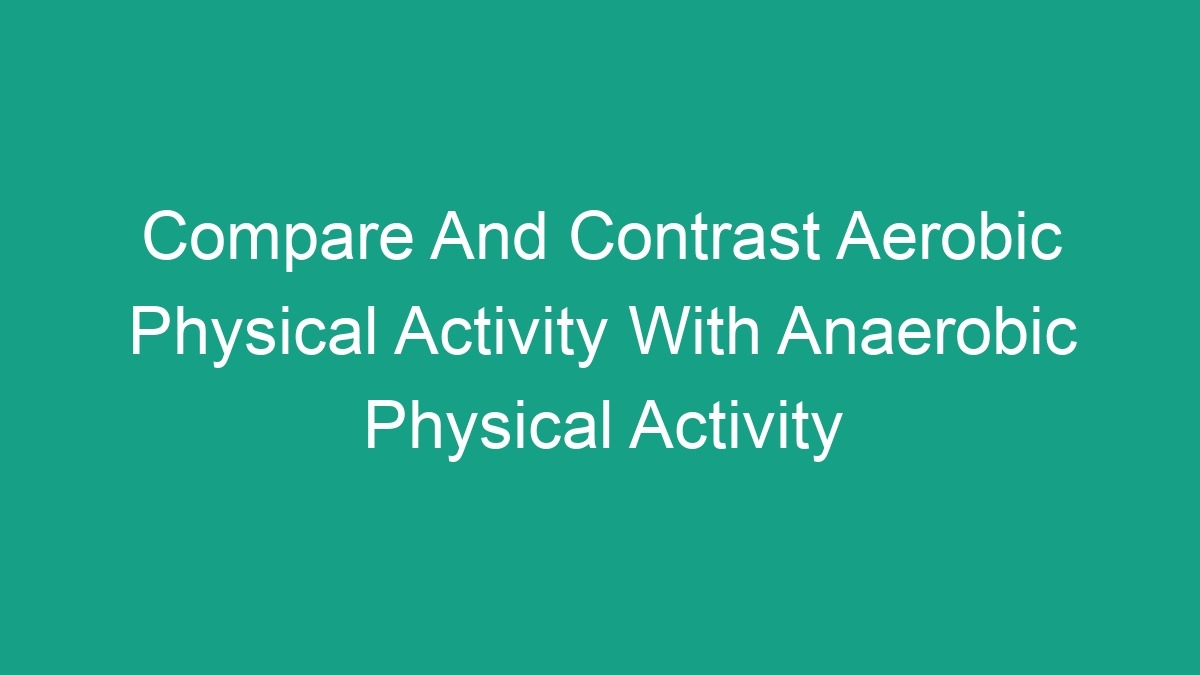
Introduction
When it comes to physical activity, two terms that are frequently used are aerobic and anaerobic. These two types of activities are fundamentally different in terms of how the body uses energy to fuel the movements. Understanding the differences between aerobic and anaerobic physical activities can help individuals design more effective workout routines and achieve their fitness goals more efficiently. In this article, we will compare and contrast aerobic physical activity with anaerobic physical activity, emphasizing their effects on the body, the types of exercises involved, and their respective benefits.
What Are Aerobic and Anaerobic Physical Activities?
Aerobic physical activity refers to exercises that primarily use oxygen to sufficiently meet the energy demands of the body during the exercise. These activities are typically performed at a moderate intensity for an extended period of time, allowing the heart and lungs to work harder to supply oxygen to the muscles. Examples of aerobic activities include walking, jogging, cycling, swimming, and dancing.
On the other hand, anaerobic physical activity involves short bursts of intense, high-energy movements that cannot be sustained for long periods without the presence of oxygen. During anaerobic exercises, the body relies on stored energy sources, such as glycogen, to fuel the muscles. Some common anaerobic activities include weightlifting, sprinting, and high-intensity interval training (HIIT).
Effects on the Body
Aerobic Physical Activity: When engaging in aerobic activities, the body’s cardiovascular system, including the heart, blood vessels, and lungs, works efficiently to deliver oxygen to the muscles. This process allows the body to produce energy through the breakdown of glucose and fatty acids, resulting in improved endurance and cardiovascular fitness. Aerobic exercises also help lower blood pressure, reduce the risk of chronic diseases, and promote overall well-being.
Anaerobic Physical Activity: Anaerobic exercises primarily target the body’s fast-twitch muscle fibers, which are responsible for explosive movements and strength. As a result, anaerobic activities lead to increases in muscle mass, strength, and power. These exercises also improve the body’s ability to tolerate lactate buildup, enhancing muscle endurance during high-intensity activities.
Types of Exercises
Aerobic Physical Activity: Examples of aerobic exercises include brisk walking, running, cycling, swimming, and dancing. These activities are typically performed at a steady pace for an extended period, allowing the body to sustain the activity by utilizing oxygen as the primary energy source. Aerobic exercises can be categorized into low-impact (e.g., walking, cycling) and high-impact (e.g., running, dancing) activities.
Anaerobic Physical Activity: Anaerobic exercises often involve short bursts of high-intensity movements that push the body to its limits. Examples of anaerobic activities include weightlifting, sprinting, jumping, and plyometric exercises. These exercises require maximal effort and rely on the body’s stored energy sources to power the muscles for short durations.
Benefits of Aerobic and Anaerobic Physical Activities
Aerobic Physical Activity: The benefits of engaging in regular aerobic exercises are vast. These activities contribute to improved cardiovascular health, increased endurance, weight management, and enhanced overall well-being. Aerobic exercises also help reduce the risk of heart disease, stroke, type 2 diabetes, and certain types of cancer. Additionally, they promote better mental health by reducing stress, anxiety, and depression.
Anaerobic Physical Activity: Anaerobic exercises are essential for building strength, power, and muscle mass. By engaging in anaerobic activities, individuals can enhance their overall physical performance, increase bone density, and improve metabolic rate. These exercises are also effective in boosting anaerobic capacity and improving the body’s ability to tolerate high-intensity activities.
Training Considerations
Aerobic Physical Activity: Individuals who aim to improve their cardiovascular fitness and endurance should incorporate aerobic exercises into their workout routines. It is recommended to engage in moderate-intensity aerobic activities for at least 150 minutes per week, as per the guidelines set by the American Heart Association. These exercises can be performed continuously or in shorter bouts throughout the day.
Anaerobic Physical Activity: Those looking to build muscle, increase strength, and power should prioritize anaerobic exercises in their training programs. It is imperative to allow adequate rest and recovery between anaerobic workouts to prevent overtraining and injury. Additionally, incorporating proper warm-ups and cooldowns is essential for preparing the muscles and reducing the risk of strains or sprains.
Combining Aerobic and Anaerobic Training
Incorporating both aerobic and anaerobic exercises into a comprehensive workout regimen can yield significant benefits. This approach, known as cross-training, allows individuals to improve their overall fitness while targeting different aspects of physical performance. For example, incorporating high-intensity interval training (HIIT), which involves alternating between short bursts of intense anaerobic exercises and periods of active recovery, can effectively improve cardiovascular fitness and promote fat loss. Similarly, combining strength training with aerobic activities can enhance overall muscular endurance and cardiovascular health.
Conclusion
In summary, aerobic and anaerobic physical activities offer distinct benefits and play crucial roles in enhancing overall fitness and health. Aerobic exercises improve cardiovascular health, endurance, and overall well-being, while anaerobic exercises focus on building strength, power, and muscle mass. Incorporating a combination of both types of exercises in a well-rounded training program can lead to improved physical performance, better health outcomes, and enhanced quality of life. It is important for individuals to understand the differences between aerobic and anaerobic activities and tailor their workouts to achieve their specific fitness goals. By doing so, they can maximize the benefits of physical activity and lead a healthier, more active lifestyle.



